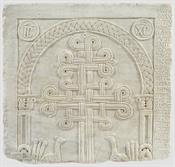ATTICA: A BYZANTINE PROVINCE
Description
Exhibition Space Text DescriptionAttica was an important province of the Byzantine Empire on account of its agricultural and industrial productivity, but also for its cultural contribution – the city of Athens, indissolubly associated with its ancient past, remained a center of learning. The closure of the philosophical schools by Justinian in 529 provoked a period of decline, though the city experienced a renewed flowering in the middle-Byzantine years.
The many-layered architectural tradition and a lasting taste for innovation were stamped on the dozens of new churches built at this time across Athens’ extensive urban fabric, with the result that a new type of church came into being, that known as Athenian. Its main features were small dimensions, harmonious proportions, an elegant eight-sided dome and carefully executed stonework with elaborate brickwork decoration. The countryside was home to structures that were humbler in both plan and materials, but met the cultic requirements of the agricultural communities.
Exhibits
-
 Dome with depictions of the Christ Pantokrator, prophets, angels and the Theotokos
Wall-paintings The dome comes from the north chapel of Spilia Pendeli, Attica, which was dedicated to Saint Nicholas. It is dated by inscrip...
Dome with depictions of the Christ Pantokrator, prophets, angels and the Theotokos
Wall-paintings The dome comes from the north chapel of Spilia Pendeli, Attica, which was dedicated to Saint Nicholas. It is dated by inscrip... -
 Marble closure slab
Sculpture Closure slab i.e. plaque from the barrier of the presbyterium or templon screen that separated the sanctuary or presbytery, t...
Marble closure slab
Sculpture Closure slab i.e. plaque from the barrier of the presbyterium or templon screen that separated the sanctuary or presbytery, t...
Comments
Users must be registered and logged in to comment.
No comments found.